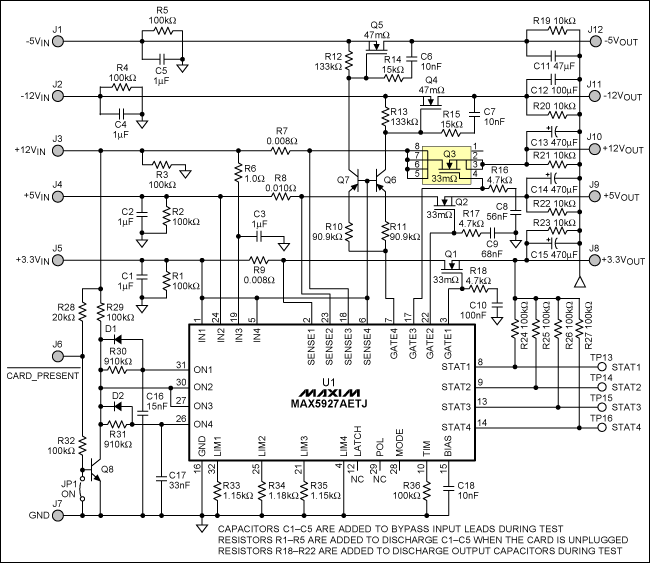Although the 5-channel circuit introduced in this article only uses a MAX5927A 4-channel hot-swappable controller, it can realize the hot-swappable function of 3 positive power supplies and 2 negative power supplies. The circuit in Figure 1 meets the following load power supply and power-on sequencing requirements:
At 2A, Ch1 = +3.3V (circuit is powered off at ≥ 3A)
At 1.6A, Ch2 = +5V (circuit is powered off at ≥ 2.4A)
At 2A, Ch3 = +12V (circuit is powered off at ≥ 3A)
At 150mA, Ch4 = -12V (no circuit power-off action)
At 50mA, Ch5 = -5V (no circuit power-off action)
The startup sequence is: Channel 2 (+5V) and Channel 3 (+12V) are turned on immediately when the active low CARD_PRESENT becomes low. STAT2 and STAT3 become high level 10.8ms after the low-level active CARD_PRESENT becomes low level.
Channel 1 (+3.3V) turns on with a delay of 11.8ms relative to Channel 2 and Channel 3. 10.8ms after channel 1 is turned on, STAT1 goes high.
Channel 4 (-12V) and Channel 5 (-5V) turn on with a delay of 27.8ms relative to Channel 2 and Channel 3. 10.8ms after channel 4 and channel 5 are connected, STAT4 becomes high level.
Latch fault management. If an error occurs in any one of Channel 1 to Channel 3, all channels will be turned off until the active low CARD_PRESENT enters the next off and on cycle.

Figure 1. 5-channel hot-swap circuit controls 3 positive supplies and 2 negative supplies
All reference designs on this site are sourced from major semiconductor manufacturers or collected online for learning and research. The copyright belongs to the semiconductor manufacturer or the original author. If you believe that the reference design of this site infringes upon your relevant rights and interests, please send us a rights notice. As a neutral platform service provider, we will take measures to delete the relevant content in accordance with relevant laws after receiving the relevant notice from the rights holder. Please send relevant notifications to email: bbs_service@eeworld.com.cn.
It is your responsibility to test the circuit yourself and determine its suitability for you. EEWorld will not be liable for direct, indirect, special, incidental, consequential or punitive damages arising from any cause or anything connected to any reference design used.
Supported by EEWorld Datasheet